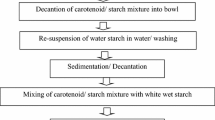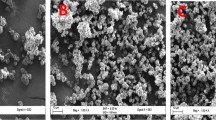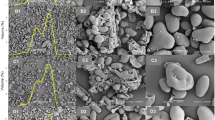Abstract
The aim of the present study was to evaluate some chemical and mineral characteristics and functional and rheological properties of Canna and Arrowroot starches produced in the Venezuelan Andes. Canna starch showed a higher (P < 0.05) moisture, ash, and crude protein content than arrowroot starch, while crude fiber, crude fat, and amylose content of this starch were higher (P < 0.05). Starches of both rhizomes own phosphorus, sodium, potassium, magnesium, iron, calcium, and zinc in their composition. Phosphorus, sodium, and potassium are the higher in both starches. Water absorption, swelling power, and solubility values revealed weak bonding forces in Canna starch granules; this explained the lower gelatinization temperature and the substantial viscosity development of Canna starch during heating. Arrowroot starch showed a higher gelatinization temperature measure by DSC, than Canna starch and exhibited a lower value of ΔH. Both starches show negative syneresis. The apparent viscosity of Canna starch was higher (P < 0.05) than the Arrowroot starch values. The size (wide and large) of Canna starch granules was higher than arrowroot starch. From the previous results, it can be concluded that Canna and Arrowroot starches could become interesting alternatives for food developers, depending on their characteristics and functional properties.
Similar content being viewed by others
References
Pérez EE, Breene WM, Bahnassey YA (1998) Variations in the gelatinization profiles of cassava, sagu, and arrowroot native starches as measured with different thermal and mechanical methods. Starch/Stärke 50: 70–72.
Erdman MD (1986) Starch from arrowroot (Maranta arundinacea) grown at Tifton, Georgia. Cereal Chem 63: 277–279.
Shipman L (1967) Manufacture of tapioca, arrowroot, and sago Starch. In: Whistler RL, Paschall EF (eds.), Starch: Chemistry and Technology, Vol. II. New York: Academic, pp 103–119.
Lii Ch Y, Chang YH (1991) Study of starch in Taiwan. Food Rev Int 7: 185–203.
Wootton M, Bamunuarachchi M (1978) Water binding capacity of commercial produced native and modified starches. Starch/Stärke 30: 306–309.
Hermann M (1996) Starch noodles from edible canna In: Janick J (ed.), Progress in New Crops. Arlington, VA: ASHD.
Kim K, Yoon HK, Kim SK (1984) Physicochemical properties of arrowroot starch. J Korean Agric Chem Soc 27: 245–251.
Lorenz K, Kulp K (1982) Cereal- and root starch modification by heat-moisture treatment. I. Physico-chemical properties. Starch/Stärke 34: 50–54.
Ciacco CF, D'Appolonia BL (1977) Characterization of starches from various tubers and their use in bread-baking. Cereal Chem 54: 1096–1107.
Perez EE, Breene WM, Bahnassey YA (1998) Gelatinization profiles of Peruvian carrot, cocoyam, and potato starches as measured with the Brabender viscoamylograph, rapid visco-analyzer, and differential scanning calorimeter. Starch/Stärke 50: 14–16.
AACC (2000) Cereal Laboratory Methods [methods 08-12, 15-A, 32-10, 46-13, and 61-01]. St. Paul, MN: The American Association of Cereal Chemists.
Schoch TJ (1964) Fatty substances in starch. In: Whistler RL (ed.), Methods in Carbohydrate Chemistry, Vol. IV, Chap. 26. New York: Academic, pp 56–61.
Juliano BO (1971) A simplified assay for milled-rice amylose. Cereal Sci Today 16: 334–340.
A.O.A.C. (1990) Official Methods of Analysis, 13th edn. Washington, DC: Association of Official Analytical Chemists.
Gonzalez Z, Peréz E (2002) Effect of acetylation on some properties of rice starch. Starch/Stärke 54: 148–154.
Lund DB (1983) Application of differential scanning calorimetry in food. In: Peleg M, Bagley EB (eds.), Physical Properties of Foods, Chap. 4. Westport, CT: Van Nostrand Reinhold, pp 125–143.
Smith RJ (1976) Characterization and Analysis of Starches. In: Whistler RL, Paschall EF (eds.), Starch: Chemistry and Technology, Vol. II, Chap. 25. New York: Academic, pp 569–635.
Author information
Authors and Affiliations
Corresponding author
Rights and permissions
About this article
Cite this article
Pérez, E., Lares, M. Chemical Composition, Mineral Profile, and Functional Properties of Canna (Canna edulis) and Arrowroot (Maranta spp.) Starches. Plant Foods Hum Nutr 60, 113–116 (2005). https://doi.org/10.1007/s11130-005-6838-9
Issue Date:
DOI: https://doi.org/10.1007/s11130-005-6838-9




